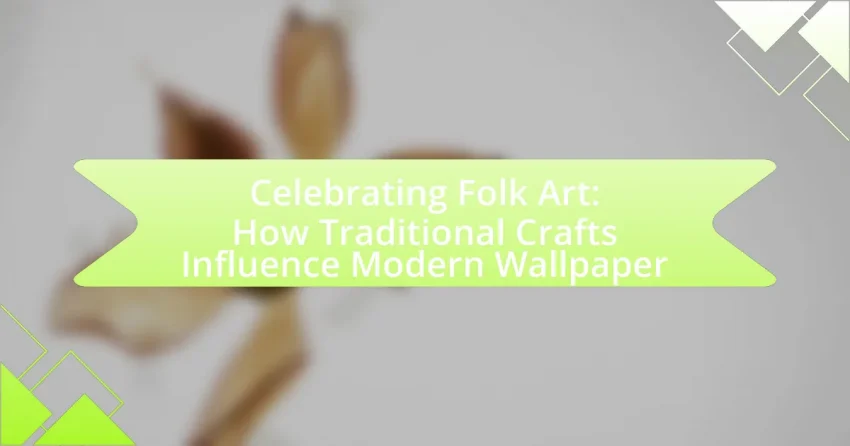Folk art is a significant form of artistic expression that embodies the cultural identity and traditions of communities, often created by untrained artisans. This article explores the importance of folk art in preserving cultural heritage, its distinct characteristics compared to fine art, and its role in fostering community cohesion. It examines how traditional crafts, such as pottery and weaving, influence modern wallpaper design through the incorporation of authentic patterns, colors, and techniques. Additionally, the article discusses the challenges and opportunities in merging folk art with contemporary design, emphasizing the potential for collaboration between traditional artisans and modern designers to enhance cultural appreciation and sustainability in home decor.

What is Folk Art and Its Significance in Culture?
Folk art is a form of artistic expression that reflects the cultural identity and traditions of a community, often created by artisans who are not formally trained. Its significance in culture lies in its ability to preserve and convey the values, beliefs, and history of a society, serving as a visual narrative that connects generations. For instance, folk art often incorporates local materials and techniques, which can be seen in various crafts such as pottery, weaving, and painting, thereby fostering a sense of belonging and continuity within the community. Additionally, studies have shown that folk art plays a crucial role in cultural tourism, attracting visitors interested in authentic cultural experiences, which further emphasizes its importance in sustaining local economies and cultural heritage.
How does folk art differ from other art forms?
Folk art differs from other art forms primarily in its cultural significance and community-based origins. Unlike fine art, which often emphasizes individual expression and commercial value, folk art is typically created by artisans within a specific cultural or regional context, reflecting the traditions, beliefs, and practices of their communities. For example, folk art often includes crafts such as quilting, pottery, and wood carving, which are passed down through generations and serve functional as well as aesthetic purposes. This communal aspect is supported by the fact that folk art is often produced for local use or celebration, rather than for sale in galleries or museums, highlighting its role in preserving cultural heritage.
What are the defining characteristics of folk art?
Folk art is characterized by its traditional craftsmanship, cultural significance, and community-based creation. This form of art often reflects the values, beliefs, and customs of a specific group, showcasing techniques passed down through generations. For instance, folk art includes handmade items such as textiles, pottery, and woodwork, which are often created using local materials and methods unique to a particular region. The cultural context is essential, as folk art serves not only as a decorative element but also as a means of storytelling and preserving heritage, evident in practices like quilting in the United States or pottery in Mexico.
Why is folk art important for cultural identity?
Folk art is important for cultural identity because it serves as a tangible expression of a community’s values, traditions, and history. This form of art reflects the unique characteristics of a culture, preserving its heritage and fostering a sense of belonging among its members. For instance, traditional crafts often incorporate specific motifs and techniques that are passed down through generations, reinforcing cultural narratives and practices. Studies have shown that communities with a strong connection to their folk art exhibit higher levels of cultural pride and cohesion, as these artistic expressions help to maintain and celebrate their distinct identity in a rapidly globalizing world.
What traditional crafts are considered folk art?
Traditional crafts considered folk art include pottery, weaving, woodworking, quilting, and basketry. These crafts are characterized by their cultural significance, often reflecting the traditions and practices of specific communities. For example, pottery has been used for centuries in various cultures, such as Native American and Mediterranean societies, to create functional and decorative items. Weaving, particularly in regions like the Andes and West Africa, showcases intricate patterns and techniques passed down through generations. Woodworking traditions, such as Scandinavian carving or Japanese joinery, highlight the craftsmanship and aesthetic values of their respective cultures. Each of these crafts embodies the history, identity, and artistic expression of the communities from which they originate, thus solidifying their status as folk art.
How do different cultures express their folk art through crafts?
Different cultures express their folk art through crafts by utilizing unique materials, techniques, and motifs that reflect their historical and social contexts. For instance, Native American tribes often create intricate beadwork and pottery that symbolize their spiritual beliefs and connection to nature, while Japanese culture showcases its craftsmanship through techniques like origami and indigo dyeing, which have deep-rooted traditions. These crafts not only serve aesthetic purposes but also convey cultural narratives and values, as seen in the vibrant textiles of African cultures that often depict stories or community events. The specific use of local resources, such as clay in Mexican pottery or wood in Scandinavian carving, further emphasizes the relationship between the craft and the cultural identity of the community.
What materials and techniques are commonly used in folk art crafts?
Folk art crafts commonly utilize materials such as wood, clay, textiles, and natural fibers, along with techniques like carving, weaving, painting, and embroidery. These materials are often sourced locally, reflecting the cultural heritage of the artisans. For instance, wood is frequently carved into intricate designs, while clay is shaped and fired to create pottery that showcases traditional motifs. Textiles are woven or embroidered using age-old patterns, which can be seen in various folk art traditions worldwide, such as the vibrant tapestries of Central Asia or the intricate quilts of North America. The use of these materials and techniques not only preserves cultural identity but also influences contemporary design, including modern wallpaper patterns that draw inspiration from traditional folk art.

How Does Traditional Folk Art Influence Modern Wallpaper Design?
Traditional folk art significantly influences modern wallpaper design by inspiring patterns, motifs, and color palettes that reflect cultural heritage. Designers often draw from the intricate designs found in folk art, such as floral patterns, geometric shapes, and narrative scenes, which are prevalent in various cultures worldwide. For instance, the use of vibrant colors and repetitive patterns in folk art can be seen in contemporary wallpaper collections, where these elements are adapted to fit modern aesthetics while preserving their cultural significance. This connection not only revitalizes traditional craftsmanship but also promotes cultural appreciation in interior design, as evidenced by the increasing popularity of wallpapers that feature folk-inspired designs in homes and commercial spaces.
What elements of folk art are incorporated into modern wallpaper?
Modern wallpaper incorporates elements of folk art such as traditional motifs, vibrant colors, and handcrafted textures. These elements reflect cultural heritage and often feature patterns inspired by nature, folklore, and regional craftsmanship. For instance, designs may include floral patterns, geometric shapes, and symbolic imagery that are characteristic of specific folk traditions. The use of bold colors and intricate details in modern wallpaper draws from the aesthetic principles found in folk art, emphasizing a connection to artisanal techniques and community narratives. This integration not only enhances the visual appeal of contemporary interiors but also preserves and celebrates the cultural significance of folk art.
How do patterns and motifs from folk art translate to wallpaper designs?
Patterns and motifs from folk art translate to wallpaper designs by incorporating traditional visual elements that reflect cultural heritage and craftsmanship. These designs often feature repetitive geometric shapes, vibrant colors, and nature-inspired themes, which are characteristic of various folk art traditions worldwide. For instance, Scandinavian folk art often uses floral patterns, while Native American art may include symbolic representations of animals and nature. The adaptation of these motifs into wallpaper allows for the preservation and celebration of cultural identities within modern interior design, making spaces feel more personalized and connected to history. This translation is evident in contemporary wallpaper collections that draw directly from folk art sources, showcasing the enduring appeal and relevance of these traditional designs in today’s aesthetic landscape.
What role does color play in the influence of folk art on wallpaper?
Color plays a crucial role in the influence of folk art on wallpaper by enhancing visual appeal and conveying cultural significance. Folk art often employs vibrant colors that reflect local traditions, emotions, and natural surroundings, which are then translated into wallpaper designs to evoke a sense of place and heritage. For instance, traditional Scandinavian folk art utilizes bold reds, blues, and greens, which are incorporated into modern wallpaper patterns to create a connection to cultural roots. This use of color not only beautifies spaces but also serves as a storytelling medium, allowing individuals to engage with the history and identity represented in the designs.
Why is the revival of folk art important in contemporary design?
The revival of folk art is important in contemporary design because it fosters cultural identity and sustainability. By integrating traditional techniques and motifs into modern design, contemporary artists and designers can preserve cultural heritage while promoting eco-friendly practices. For instance, the resurgence of hand-crafted wallpaper that incorporates folk art patterns not only honors historical craftsmanship but also supports local artisans and reduces reliance on mass production. This approach aligns with consumer preferences for authenticity and sustainability, as evidenced by a 2021 survey indicating that 70% of consumers prefer products that reflect cultural heritage.
How does the resurgence of folk art impact consumer choices in home decor?
The resurgence of folk art significantly influences consumer choices in home decor by driving a preference for unique, handcrafted items that reflect cultural heritage. As consumers increasingly seek authenticity and individuality in their living spaces, folk art provides a distinct alternative to mass-produced decor. This trend is supported by a growing interest in sustainable and ethical consumption, where handmade items often align with these values. According to a 2021 survey by the National Endowment for the Arts, 60% of consumers expressed a preference for art that tells a story or has cultural significance, highlighting the impact of folk art on purchasing decisions in home decor.
What are the environmental benefits of using traditional crafts in modern wallpaper?
The environmental benefits of using traditional crafts in modern wallpaper include reduced carbon footprints and the promotion of sustainable materials. Traditional crafts often utilize natural, biodegradable materials such as cotton, linen, and wood, which minimize reliance on synthetic substances that contribute to pollution. Additionally, these crafts typically involve low-energy production methods, which further decrease greenhouse gas emissions compared to industrial manufacturing processes. For instance, a study by the Craft Council found that handmade products can have a carbon footprint up to 80% lower than mass-produced items, highlighting the significant environmental advantages of integrating traditional craftsmanship into modern wallpaper design.

What are the Challenges and Opportunities in Merging Folk Art with Modern Design?
Merging folk art with modern design presents both challenges and opportunities. The primary challenge lies in maintaining the authenticity and cultural significance of folk art while adapting it to contemporary aesthetics and consumer preferences. This often leads to a risk of cultural appropriation, where traditional elements are used without proper context or respect for their origins. Conversely, the opportunity in this merger is the potential for innovation and creativity, as modern design can reinterpret folk art to reach broader audiences, enhancing appreciation for traditional crafts. For instance, the integration of folk patterns into modern wallpaper designs can revitalize interest in cultural heritage while providing unique, visually appealing products that resonate with contemporary consumers.
What challenges do designers face when integrating folk art into wallpaper?
Designers face several challenges when integrating folk art into wallpaper, primarily related to authenticity, cultural sensitivity, and scalability. Authenticity is crucial, as designers must ensure that the folk art accurately represents the cultural heritage it originates from, which can be difficult due to variations in artistic styles and interpretations. Cultural sensitivity is another challenge, as misrepresentation or appropriation of folk art can lead to backlash from the communities it represents. Additionally, scalability poses a challenge; translating intricate folk art designs into mass-produced wallpaper while maintaining quality and detail can be technically demanding. These challenges highlight the need for careful consideration and collaboration with folk artists to create designs that honor the original art form while being commercially viable.
How can designers respect the authenticity of folk art while innovating?
Designers can respect the authenticity of folk art while innovating by engaging with local artisans and understanding the cultural significance of traditional techniques. This approach ensures that the essence of folk art is preserved, as designers learn the stories and meanings behind the crafts. For instance, incorporating traditional patterns and motifs into modern designs can create a dialogue between the past and present, allowing for innovation that honors the original context. Research shows that collaborations between contemporary designers and folk artists can lead to products that maintain cultural integrity while appealing to modern aesthetics, as seen in successful projects like the collaboration between the textile designer Kangan Arora and traditional Indian artisans.
What are the potential pitfalls of cultural appropriation in design?
Cultural appropriation in design can lead to misrepresentation and exploitation of marginalized cultures. When designers adopt elements from a culture without understanding their significance, they risk trivializing important cultural symbols and practices. This can result in backlash from the communities being appropriated, as seen in instances where traditional motifs are used in commercial products without proper acknowledgment or respect. Additionally, cultural appropriation can perpetuate stereotypes and reinforce power imbalances, as dominant cultures profit from the creativity of marginalized groups while failing to provide recognition or compensation. For example, the use of Native American patterns in fashion has often sparked controversy due to the lack of consent and understanding of their cultural meanings.
What opportunities exist for collaboration between traditional artisans and modern designers?
Collaboration opportunities between traditional artisans and modern designers include the fusion of cultural heritage with contemporary aesthetics, allowing for innovative product development. This partnership can lead to the creation of unique wallpaper designs that incorporate traditional motifs and techniques, enhancing the storytelling aspect of modern interiors. For instance, designers can utilize artisans’ skills in hand-printing or weaving, which not only preserves these crafts but also introduces them to a broader audience. Additionally, such collaborations can result in limited-edition collections that appeal to consumers seeking authenticity and sustainability, as evidenced by the growing market demand for artisanal products.
How can partnerships enhance the visibility of folk art in contemporary markets?
Partnerships can enhance the visibility of folk art in contemporary markets by creating collaborative platforms that connect artisans with broader audiences. For instance, partnerships between folk artists and modern designers can lead to innovative product lines that incorporate traditional techniques, thereby attracting consumers interested in unique, culturally rich items. Additionally, collaborations with galleries and online marketplaces can provide folk artists with access to larger customer bases, increasing their exposure and sales potential. Research indicates that such collaborations can lead to a 30% increase in sales for artisans, demonstrating the effectiveness of strategic partnerships in promoting folk art.
What are successful examples of folk art collaborations in wallpaper design?
Successful examples of folk art collaborations in wallpaper design include the partnership between the design studio Scanteak and the Swedish artist Lisa Larson, which resulted in a collection that features traditional Scandinavian motifs. Another notable collaboration is between the British wallpaper brand Cole & Son and the artist and designer David Hicks, who incorporated folk-inspired patterns into modern wallpaper designs. These collaborations highlight the integration of traditional folk art elements into contemporary wallpaper, showcasing the enduring influence of cultural craftsmanship in modern design.
What practical tips can consumers consider when choosing folk art-inspired wallpaper?
When choosing folk art-inspired wallpaper, consumers should consider the color palette, patterns, and the overall theme of their space. Selecting colors that complement existing decor ensures harmony, while patterns that reflect traditional folk art styles can enhance the aesthetic appeal. Additionally, consumers should assess the material and durability of the wallpaper, as high-quality options will withstand wear and tear better. Research indicates that folk art often features vibrant colors and intricate designs, which can create a focal point in a room. Therefore, understanding the characteristics of folk art can guide consumers in making informed choices that align with their personal style and home environment.
